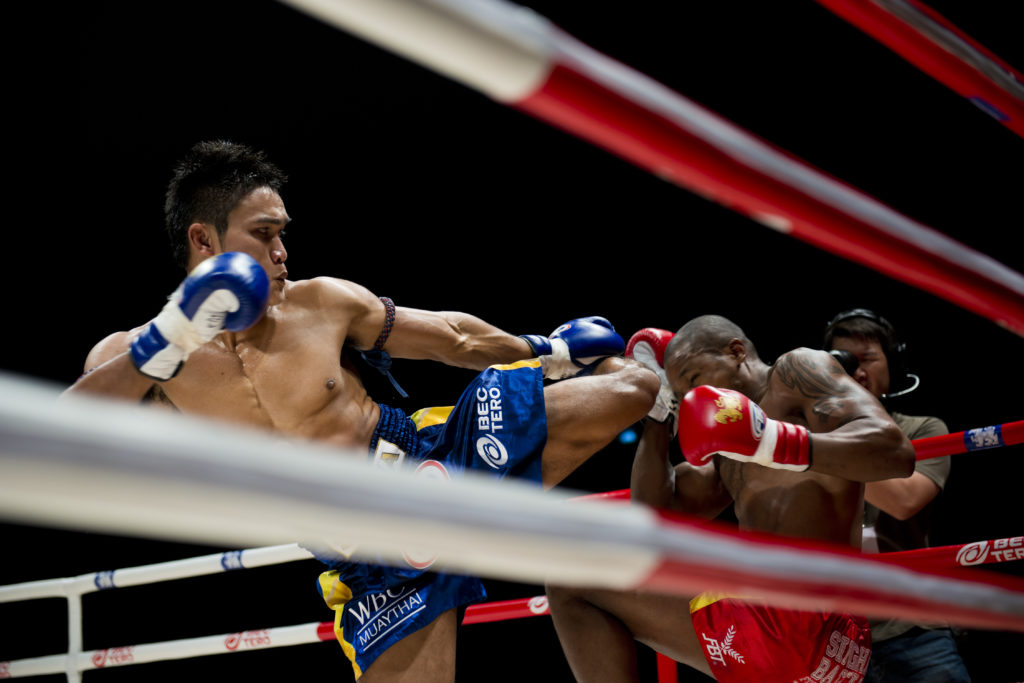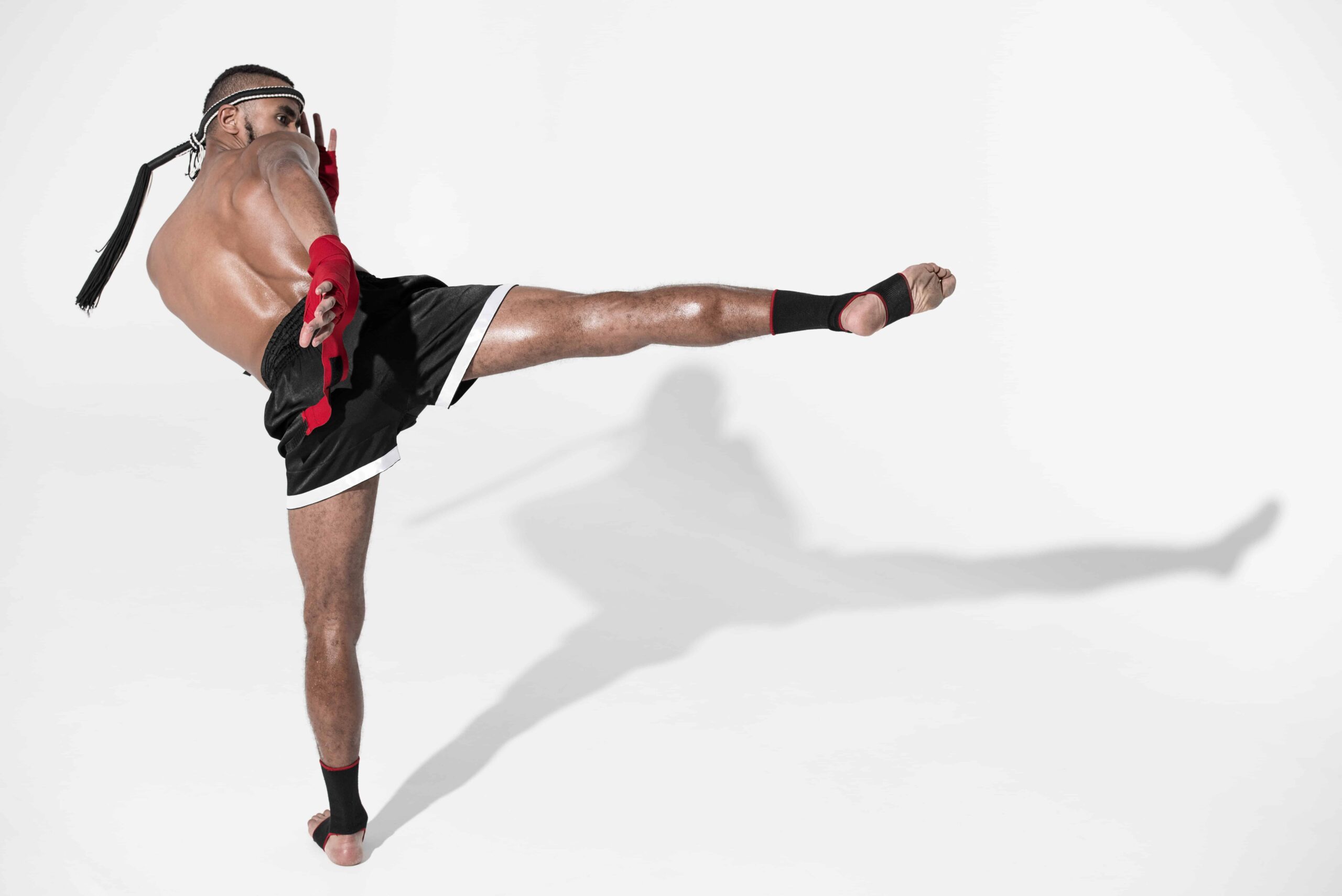In general there are two main types of muay thai kicks, straight kicks and round kicks.
However within the straight and roundhouse types of muay thai kicks there are 10 different types of muay thai kicks that have Thai names.
The 10 types of muay thai kicks that will be looked at in this post are:
- Muay Thai Roundhouse Kick – Tae Tat
- Side Kick – Tae Tad
- Straight Foot Jab – Teep Trong
- Slapping Foot Thrust – Teep Top
- Muay Thai Axe Kick – Tae Khao
- Diagonal Kick – Tae Chiang
- Downward Rounhouse Kick – Ta Kot
- Straight Front Kick – Tae Trong
- Jumping Push Kick – Kradot Teep
- Spinning Reverse Roundhouse – Tae Klap Lang
So let’s look at each of these 10 types of muay thai kicks in more detail.
1. Muay Thai Roundhouse Kick – Te Tat
The most famous and commonly used kick in muay thai is probably the muay thai roundhouse kick to the body.
Also known as the ’round kick’ in MMA and kickboxing.
This kick can be thrown from the rear or lead side.
This is a very powerful kick that aims to strike with the shin against the opponents legs, mid section or head.

Though the muay thai roundhouse kick to the body is the most frequently used in a muay thai fight.
Unlike other martial arts ’round’ kicks that strike with the instep or foot.
The muay thai roundhouse strikes with the shin and requires good hip and body rotation to generate power.
2. Muay Thai Side Kick – Te Tad
The muay thai side kick is similar to the karate side kick and other side kicks used in striking arts such as Tae Kwan Do.
As with other side kick types the muay thai side kick involves chambering the kicking leg before firing out the side kick in a powerful thrusting motion to the target.
The muay thai side kick can be aimed at different targets much like the round kick of muay thai.
It can be thrown with the lead or rear leg.
A Master of the Thai Side- Kick is legend Samart Payakaroon – check out how Samart used the Thai side kick in the video below.
The main difference being that a forward step is used in muay thai the opposite leg (standing leg) before firing out the side kick from the kicking leg.
In Karate as demonstrated below more power is obtained by ‘chambering’ the kick as opposed to stepping forward to generate power and thrust.
3.Straight Foot Jab – Teep Trong
The straight foot jab is an effective technique to catch your oppoent and off balance them or to counter their attacks as they close the distance to throw them.
The straight foot jab or teep trong is a ‘long’ technique and is commonly used in a similar fashion to the boxing jab.
It is a very effective long weapon that can be used to control distance and stop your opponent from moving in on you.
It is usually aimed at the opponents mid section.
4. Slapping Foot Thrust – Teep Top
The teep top muay thai kick involves bending the kicking knee and using a quick leg extension to hit the target with your foot.
Usually the top of the foot is used but also the whole foot can be used to strike the target with this technique.
This kick can be used defensively to keep an opponent off you or to affect your opponents balance and drive them backwards.
5. Muay Thai Axe Kick – Tae Khao
The Axe kick of muay thai targets the face/head and shoulder area of the opponent.
The targets are the forehead, nose, face and shoulder of the opponent.
The kick involves keeping the kicking leg straight and driving the kick down onto the target.
Muay thai great Saenchai is known for efffectively using the muay thai Axe kick and his great leg dexterity and flexbility allows Saenchai to land this kick effectively.
The muay thai Axe kick is not commonly used as it leaves the kicker open to be swept off the standing leg or to be countered quickly while executing the kick.
6. Diagonal Kick – Tae Chiang
The diagonal kick is a very quick upward angling kick aimed at the opponents lower rib-cage and striking with the shin.
The diagonal kick or tae chiang is very quick and efficient angling up in a 45 degree angle from the floor up into the target.
7. Downward Roundhouse Kick – Tae Kod
This kick is also known as the Question Mark Kick or Brazilian Kick.
The downward muay thai round kick or tae kod is also used in Karate where it is known as Otoshi Mawashi Geri.
It is also referred to as the ‘hook kick’ due to the hooking action of your leg on the target when driving the kick downward.
The motion is similar to the standard roundhouse kick but requires the kicking leg to be lifted up higher and then angled down.
This requires good hip mobility in order to turn the hip over and get that hooking action.
The kick can be used when the opponent is ducking down in a lower position.
Or, with good flexibility the downward kick can be delivered from a standing position against an upright opponent by going up and over the guard and coming down on the face or neck area.
8. Straight Front Kick – Tae Trong
The straight front kick is a quick upward action kick that can strike with the toes or top of the foot rather than the foots sole.
It is usually aimed at the upper region of your opponents body usually the face area.
This kick is also used in Karate where it is known as Mae Geri in Japanese.
9. Jumping Push Kick – Kradot Teep
The straight kick is the teep in Thai and kradot is to jump.
The jump allows for more power generation into the teep which can be aimed at higher targets due to the elevation from the jump.
This includes the face and upper chest area of the opponent.
A great deceptive technique is to raise the lead leg as if throwing a normal lead straight kick.
And hop off of the rear leg to land the jumping rear straight kick which can knock your opponent down if executed well.
10. Spinning Round Kick – Tae Klap Lang
The spinning round kick is a flashy kick but also very effective and powerful.
It can be used in a more defensive fashion when backing up or when tracking your opponent down in a more offensive manner.
It is performed mostly with the rear leg. and involves giving your back to your opponent in order to generate the required momentum in a spinning action that will transfer power to the kicking leg.
The target of this kick is usually in the upper chest and head area of the opponent.
This kick requires good hip mobility and flexibility and dexterity in your legs which can all be developed over time.




